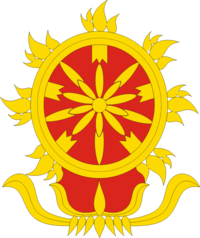Kostrad
| Kostrad | |
|---|---|

Insignia of Kostrad
|
|
| Active | 1961 – present |
| Country |
|
| Branch |
|
| Type |
|
| Role | combat and warfare reserve corps |
| Size | 27,000 (1998) |
| Part of |
|
| Headquarters | Jakarta |
| Nickname(s) | Cakra! |
| Motto(s) | Dharma Putra |
| Anniversaries | 6th of March |
| Commanders | |
| Kostrad Commanders | Lieutenant General Edy Rahmayadi |
| Kostrad Chief of Staff | Major General Cucu Sumantri |
Kostrad (Komando Cadangan Strategis Angkatan Darat: "Army Strategic Reserve Command ") is a formation of the Indonesian Army. Kostrad is a Corps level command which has up to 35,000 troops. It also supervises operational readiness among all commands and conducts defence and security operations at the strategic level in accordance with policies of the TNI commander. Kostrad is the main basic warfare combat unit of the Indonesian Army, while Kopassus is the elite-special forces of the Indonesian Army, Kostrad still maintains as the first-line combat unit of the TNI below the Kopassus. This corps has two divisions which are:
As a corps, Kostrad is commanded by a Panglima (Commander), usually a lieutenant general. Kostrad falls under the army chief of staff for training, personnel, and administration. However, it comes under the Commander-in-Chief of the Indonesian National Armed Forces for operational command and deployment. Kostrad typically receives best equipments in the Army and its two armoured battalions will soon receive Leopard 2A4 and Leopard 2 Revolution tanks.
Starting 1984 the (Pangkostrad) has been charged to lead the conduct of combat operations, called defence and security operations.
Kostrad came into being during military action for Indonesia's take over of Western New Guinea in 1960, and was formally constituted on 6 March 1961. Initially designated the Army General Reserve Corps, its name was changed to Kostrad in 1963.
General Suharto, was appointed as the first head of Kostrad in 1961, and it was in this role that he was able assert the army's control in the days following the abortive coup attempt on the evening of 30 September 1965, which ultimately led to Suharto replacing Sukarno as Indonesian president.
The command's troops have fought in most Indonesian military operations since their formation, such as G-30-S/PKI (30 September Movement/Indonesian Communist Party), Trisula, the PGRS (Sarawak People's Guerrilla Force) in Sarawak, the PARAKU (North Kalimantan People's Force) in North Kalimantan, and Operation Seroja in East Timor.
...
Wikipedia
